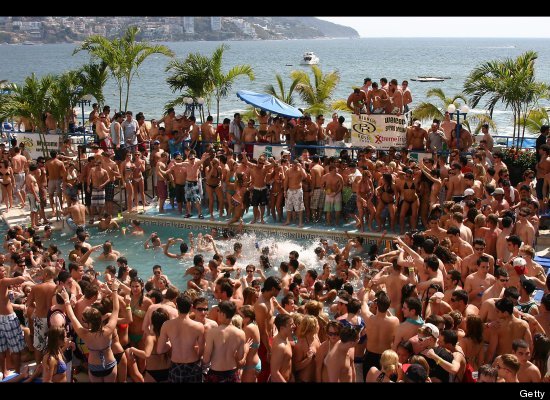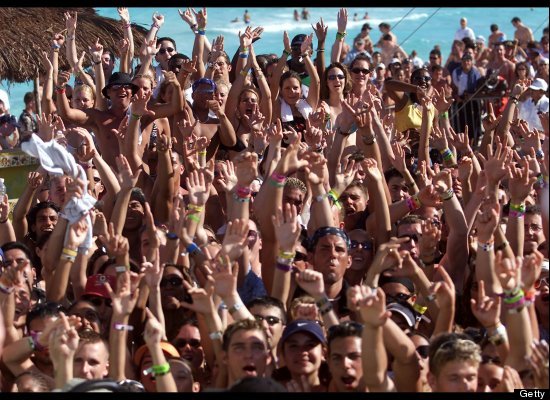While Spring Breakers rejoice with the idea of sunny beaches, 18 year-old drinking age and all-inclusive fun that Mexico has to offer, what do Mexicans think about their visitors? How do locals feel about this holiday of debauchery?
At HuffPost LatinoVoices we decided to ask some of our Mexican friends to give us some of their perspective on the subject.
These are what the locals had to say about Cancun's Spring Breakers:
Thanks to the HuffingstonPost

"A Beach Resort In New York City"?
"As a Mexican, its pretty sad what's become of Cancun. It's ridiculous how Cancun doesn't even feel like Mexico any more. Although, geographically it is on a map, everyone speaks English and sometimes you feel you're on a beach resort in New York City."
"I hate how irresponsibly [spring breakers] act. They get wasted and jeopardize their own safety, not to mention that they later blame their troubles on the safety of the country and not their behavior."
- Andrew Rogers was born in New York but raised in Mexico City. He went to Cancun for Spring Break for his senior class trip in high school back in 2007.
"I hate how irresponsibly [spring breakers] act. They get wasted and jeopardize their own safety, not to mention that they later blame their troubles on the safety of the country and not their behavior."
- Andrew Rogers was born in New York but raised in Mexico City. He went to Cancun for Spring Break for his senior class trip in high school back in 2007.
It's a 'Spring Break cliche'
"If you're into the whole spring break thing, it's the best place to go. Everything is organized so you can have that type of experience--the music, the bars, the huge drinks, ridiculous shots, etc."
"But the parties get a bit nasty. I personally don't like the music or the atmosphere, precisely because it's so 'spring break cliche'. Everyone is always wasted, doing something stupid--yelling on the street, puking, unconscious girls everywhere. When I visit Cancun I try to stir away from the hotel area and from the area with the insane clubs. I'll leave those for the tourists!"
-Ornella Cremasco is from Mexico City. She went to Cancun for Spring Break for his senior class trip in high school, but visits Cancun.
"But the parties get a bit nasty. I personally don't like the music or the atmosphere, precisely because it's so 'spring break cliche'. Everyone is always wasted, doing something stupid--yelling on the street, puking, unconscious girls everywhere. When I visit Cancun I try to stir away from the hotel area and from the area with the insane clubs. I'll leave those for the tourists!"
-Ornella Cremasco is from Mexico City. She went to Cancun for Spring Break for his senior class trip in high school, but visits Cancun.

The Country Loses the Mexican Charm
"Cancun loses a bit of the Mexican charm because all the restaurants and other establishments start catering specifically to the American tourists. I feel like the 'mexicanness' of the place is lost."
"Some establishments really appreciate the business that American tourists bring. It all depends which Mexicans you ask--the vacationers on the beaches or the locals in the place. This is from the perspective of a Mexican who lives in a city away from the beach and likes to feel she is in Mexico when she goes to vacation in her country."
-Patricia R. Zablah is originally from Monterrey. She's spent spring break in Cancun and Puerto Vallarta.
"Some establishments really appreciate the business that American tourists bring. It all depends which Mexicans you ask--the vacationers on the beaches or the locals in the place. This is from the perspective of a Mexican who lives in a city away from the beach and likes to feel she is in Mexico when she goes to vacation in her country."
-Patricia R. Zablah is originally from Monterrey. She's spent spring break in Cancun and Puerto Vallarta.
Spring Breakers Have No Interest In The Culture
"Spring Breakers have no interest in understanding and getting to know the local culture, yet they feel they've 'been to Mexico.'"
-Fernanda Chouza who grew up in Mexico City and has spent many Spring Break holidays in Acapulco.
-Fernanda Chouza who grew up in Mexico City and has spent many Spring Break holidays in Acapulco.
"It's the Disney Land of Debauchery"
"What shocked me the most was the grinding. I was amazed at how guys would just come up to girls and basically start humping them and the girls would stick out their bottoms out to get thrusted upon. I mean the Mexican dance floor courtship has the same objective in mind (namely getting laid) but its much more roundabout - guys ask you to dance, they buy you drinks, they ask what your name is, etc.
"But the thing about Cancun is that it's not a real place. It's what 20 somethings from the States want it to be and they don't want it to be a real place, so that the things they do there don't really count--like having sex in clubs (which I saw people doing), or dancing on a stage (with a pole that the club has generously supplied for you)."
"They think they've been to Mexico, but really they've been to the Disney Land of debauchery, built especially for them."
-Sofia Ortiz from Mexico City went to Cancun during the Spring Break of her senior year in high school.
"But the thing about Cancun is that it's not a real place. It's what 20 somethings from the States want it to be and they don't want it to be a real place, so that the things they do there don't really count--like having sex in clubs (which I saw people doing), or dancing on a stage (with a pole that the club has generously supplied for you)."
"They think they've been to Mexico, but really they've been to the Disney Land of debauchery, built especially for them."
-Sofia Ortiz from Mexico City went to Cancun during the Spring Break of her senior year in high school.
Can You Do Spring Break As A Married Man?
As a single man, "if you speak English, you can even become part of [the Spring Breakers] group: you join them, drink with them, dance with them in clubs. You have a great time. If you go on a type of 'casanova plan' you have a good chance in ending in a room of a girl.
As a married man, "if you are planning on going to relax, the reality is you can't. The hotels (especially those that are all inclusive) have boys and girls who are drunk every hour of the day. There's always some activity for them that includes alcohol and sometimes wet t-shirt contests. So if you are going and you're married, you're best bet is to leave the hotel. Being part of the spring breaker groups is no longer the option."
As a married man, with children, "it's impossible. I lived the experience and our best option was to leave the hotel all day. Sometimes you see drunk kids in the beach or puking around. A display you wouldn't want your kids to see. The party goes on into the wee hours of the morning in the bars and clubs and even in your own hotel so going with your kids is impossible."
- Alberto Sanchez, AOL Latino Homepage Senior Editor, is originally from Mexico and has spent two spring breaks in Cancun and one in Acapulco.
As a married man, "if you are planning on going to relax, the reality is you can't. The hotels (especially those that are all inclusive) have boys and girls who are drunk every hour of the day. There's always some activity for them that includes alcohol and sometimes wet t-shirt contests. So if you are going and you're married, you're best bet is to leave the hotel. Being part of the spring breaker groups is no longer the option."
As a married man, with children, "it's impossible. I lived the experience and our best option was to leave the hotel all day. Sometimes you see drunk kids in the beach or puking around. A display you wouldn't want your kids to see. The party goes on into the wee hours of the morning in the bars and clubs and even in your own hotel so going with your kids is impossible."
- Alberto Sanchez, AOL Latino Homepage Senior Editor, is originally from Mexico and has spent two spring breaks in Cancun and one in Acapulco.
It's All About The Alcohol
"Many Mexicans think of Spring Breakers as young people who have no clue about anything and that instead of taking advantage of the fact that they are in another country they decide to get drunk."
-Sandra Ortiz is originally from the state of Puebla, Mexico.
-Sandra Ortiz is originally from the state of Puebla, Mexico.

It's Good For The economy, But...
"There is a big influx of money into the country's economy during Spring Break. But the problem with the Spring Breakers is they travel with 'all inclusive packages' and they usually don't leave leave tips which are there to compensate the minimum wages of people working in hotels and other entertainment places."
-Violeta Merlo, Content Editor at AOL Latino, spent some time in Cancun during this year's Spring Break.
-Violeta Merlo, Content Editor at AOL Latino, spent some time in Cancun during this year's Spring Break.







